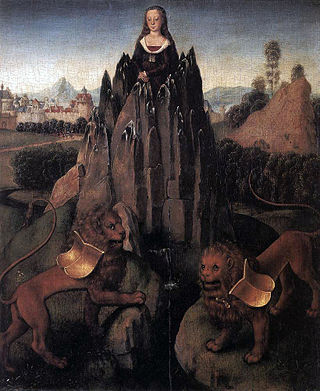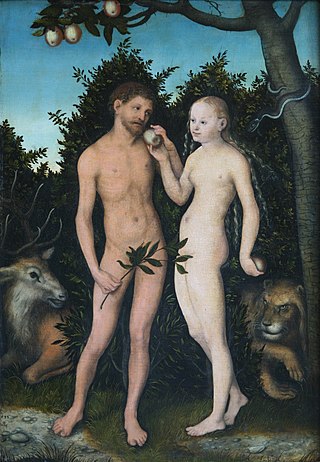Middle Ages
The church defined sin as a violation of any law of God, the Bible, or the church. [16] Common sexual sins were premarital sex, adultery, masturbation, homosexuality, and bestiality. Many influential members of the church saw sex and other pleasurable experiences as evil and a source of sin when in the wrong context, unless meant for procreation. [17] Also, any non-vaginal sex (oral, manual, anal) is sinful. The church considered masturbation a sin against nature because the guilty party was extracting sexual pleasure outside of the context of proper use. Also, law required clerics to avoid any sort of sexually tinged entertainment. [18] However, canon law did allow sex in a marriage, as long as it intended to procreate and not just provide pleasure, even though some saw sex, even in marriage, as sinful and impure. [19] Jeffrey Richards describes a European "medieval masculinity which was essentially Christian and chivalric". [20]
Sexual regulation by the church accounted for a great amount of literature and time. The church saw regulation as necessary to maintain the welfare of society. [21] Canon law banned premarital sex, lust, masturbation, adultery, bestiality, homosexuality, and any sort of sex outside of marriage. Adultery was broken up into various categories by the Statutes of Angers: prostitution and simple fornication, adultery, defloration of virgins, intercourse with nuns, incest, homosexuality, and incidental matters relating to sex such as looks, desires, touches, embraces, and kisses. [22] Adultery was typically grounds for divorce for a man if his wife fornicated with another, but adultery was not seen as a crime, just as a sin. [23] Prostitution, although within the category of fornication, was less concrete in the law. Because the medieval canon law originated as an "offshoot of moral theology" but also drew from Roman law, it contributed both legal and moral concepts to canonistic writing. [24] This split influence caused the treatment of prostitution to be more complex. Prostitution, although sinful, was tolerated. Without the availability of a prostitute, men could be led to defloration of a virgin. It was better to tolerate prostitution with all of its associated evils, than to risk the perils which would follow the successful elimination of the harlot from society. [25] The church recognized disordered sexual desire as a natural inclination related to original sin, so sexual desires could not be ignored as a reality. Although the law attempted to strictly regulate prostitution, whorehouses abounded disguised as bathhouses or operated in secret within hotels and private residences. "Outside the official public brothels, prostitution in the public bathhouses, the inns and the taverns was common knowledge and was tolerated. [26] Much of the church's efforts were put toward controlling what was going on sexually in a marriage, especially regarding when a married couple could have sex. Sex was not allowed during pregnancy or menstruation, right after a child birth, on Sunday, Wednesday, Friday, or Saturday during each of the three Lents, on feast days, quarterly ember days, or before communion. [27] The church also denounced "unnatural" sexual relations between those of the same sex and also married couples. [28] Also, upon marrying, a couple could not enter a church for thirty days. [29]
Although the church developed very strict regulations on sexual activity that needed to be carried out to sustain the institutional and psychological structure of the Middle Ages, it had a hard time properly enforcing these regulations. Most violations occurred in the privacy of the bedroom, so the only witnesses to the sin were the guilty parties themselves, and they did not usually confess to such crimes. Also, the problem was widespread. Not only did the common people deviate from the rules, but the clerics themselves did not follow their own laws. [30] In order to convict, accusation was required, and people did not usually have enough proof to back up an accusation, as law basically required a confession, and there was always a chance that if there was not enough proof, the accuser would be charged with false accusations. Even though the system was not foolproof, the church did produce a large number of institutions to inform the public of the law of sexual practice, and also had an extensive system of courts to deal with sexual misbehavior. [31]
Sexual offenses were punished in a variety of ways during the Middle Ages. [32] There were numerous prosecutions for adultery, fornication, and other sexual offenses, [33] but fornication was the most frequently prosecuted. [34] Fornication was seen as a serious sin and a canonical crime [35] and those convicted were required to "pay fines and court costs", [36] and they were often subject to public humiliation. Public humiliation ranged from public confessions and requesting the forgiveness of the community (often by kneeling at the entrance of a church and begging those who entered for mercy), [34] to public whippings in the churchyard or marketplace, [37] to being paraded around the church "bare-chested and bearing a lighted candle before Sunday Mass". [38] Some offenders were made to wear special clothes while others were flogged. Numerous offenders had to fast or abstain from meat, wine, and sex for a set period of time. [39] Other "punishments [ranged] from the cutting off of hair and pillory to prison and expulsion." [40] Those convicted of more serious sexual offenses were subject to removal from office, confinement in a monastery, or a forced pilgrimage.
Not all punishments were equal; punishments for sexual crimes differed between genders and social classes. When convicted of adultery, it was more likely that males would be fined in church courts rather than publicly flogged like the convicted females. [41] However, when the males began to be more strictly punished, the punishment for females also became more severe. While males were now publicly whipped, females had their heads shaved [42] and were subject to expulsion from their homes, separation from their children, and the confiscation of their dowry. The wounds of the male would heal over time, but the woman was reduced to "penury". [43] She would often be forced to live in poverty for the remainder of her life. In one case, a woman was accused of sleeping around and was ordered to rid herself of guilt in front of seven witnesses. Her male counterpart, however, was subject to no punishment whatsoever. When a woman of a higher social status was convicted of the same crime, she was not required to purge herself of her guilt in front of any witnesses. The woman of a higher social class was allowed to repent in private. Common prostitutes of the time period were banned from churches, but there was little to no prosecution of their "male clientele". [44] However, the priests of the higher classes were punished most severely for sexual crimes. They were stripped of their rank, position, and income. [45] The wife and children of the priest were thrown out of their house, [46] and the priests could be thrown in a monastery for the remainder of their lives and their wife and children enslaved. [34]













